Webinars are the easiest way to learn new skills, and a great way for businesses to offer value to their audience. You can use webinars for anything from walking prospects through a new product feature, to hosting a panel discussion with industry experts.
As a rule, webinars are hosted live, but to get the most from them, don’t forget to hit record and turn them into evergreen content and future lead generating machines.
Contents1.What is a Webinar?2.Benefits of Webinars for Business3.5 Types of Webinars You Need to Diversity Your Webinar Program3.1 Panel Webinars3.2 Educational Webinars3.3 Presentation Webinars (a.k.a. Keynotes)3.4 Product Webinars3.5 On-Demand Webinars4.How to Make a Webinar4.1 Have a Clear Goal in Mind4.2 Choose the Right Speaker(s)4.3 Get it in the Calendar4.4 Spread the Word4.5 Choose a Webinar Software4.6 Get a Moderator4.7 Do a Tech Rehearsal4.8 Make the Recording Available On-Demand5.Webinar Best Practices5.1Build Excitement with Webinar Teasers5.2Chop Up Your Webinars5.3Create a Webinar Video Hub5.4Score Those Webinar Leads5.5Stay in Touch with Webinar Attendees6.Where to Use Webinars7.Examples of Webinars That Get it Right7.1 Trello Webinars7.2 HubSpot Webinars7.3 IMPACT Webinars7.4 Vidyard Webinars
What is a Webinar?
Webinars are convenient virtual learning tools available to anyone with an internet connection. Like real-world seminars, webinars are educational in purpose. They can take the form of a prepared lecture, panel interview, or live Q&A session, and can be live-streamed and available on-demand.
Benefits of Webinars for Business
Webinars are one of the most popular types of video for businesses—alongside demos, how-to videos, customer testimonials, and explainer videos—according to research from Demand Metric.
There are many reasons why webinars are important for your business, but one of the biggest is the value they provide not only to you, but also to your customers. Other benefits include:
Webinars are easily accessible and low-cost to produce. There’s a good reason why 56% of companies have already invested in webinars. Without paying for a physical venue (and everything that comes with it), most webinars are easy to produce and easy to attend. If I can attend in my PJs, it’s a pretty easy ask.
Webinars generate leads. With 73% of marketing and sales leaders counting webinars as one of the best ways to generate leads, they’re quickly becoming one of the most popular forms of marketing content.
Webinars offer high value to attendees. Who doesn’t want to learn something new from the comfort of their own home or office? Speakers can also attend from anywhere in the world, making it easier for you to secure top industry professionals and thought leaders, no matter where your company is located.
Webinars are effective learning tools. The brain processes visual information 60,000x faster than text. Live-streaming allows you to use slides, video, and even screensharing to make your point. Live Q&As make for meaningful interactions and a deeper learning experience than asynchronous tutorials—or even live events where audience members might be too shy to speak up!
Webinars rank among the most useful content formats. Webinars and videos were ranked as the most effective content delivery channel by 26% of sales and marketing professionals, second only to websites and landing pages.
Webinars are a powerful way to support customers. In fact, 67% of customer service and support teams use recorded webinars—that’s even more than marketing and sales teams.
Webinars can be a very interactive video format. Q&As, surveys, chat, and polls are just a few of the most popular ways to engage live webinar attendants.
Webinars have a long lifespan. Record this valuable material and serve it up on-demand as evergreen content.

Get the Webinars Checklist
 Ready to make a webinar for your business? This list covers all the things you need to know to get it right.
Ready to make a webinar for your business? This list covers all the things you need to know to get it right.
Get the List
5 Types of Webinars You Need to Diversity Your Webinar Program
1. Panel Webinars
Panel webinars consist of one host who interviews a panel of experts or thought leaders about a certain topic via webcam. These webinars are informal and unscripted. Some even allow attendees to ask questions throughout the session. This engaging form of webinar adds credibility to your brand and highlights partners and customers as thought leaders.
Hot Tip: Logistically, panel webinars are best done with software that allows you to broadcast everyone’s webcam at once.
2. Educational Webinars
Educational webinars often take the form of a speaker relaying information through a slideshow. This format is an effective way to explain complex topics, and much like panel webinars, it’s also a great opportunity to include a variety of external speakers.
Hot Tip: Slideshows can be dry, so keep engagement up by adding in polls and videos, or consider breaking up the material into 15 to 25-minute sections.
3. Presentation Webinars (a.k.a. Keynotes)
Presentations and keynotes at live events and are perfect fodder for webinars. Simply set up a camera and live-stream the event. You can collect registrations on your homepage, and keep the recorded version on your website for future on-demand viewing.
Hot Tip: One of the best parts of re-watching keynote presentations is that you can get right to the good stuff. And with Vidyard’s speed controls, you can even watch them at x2 the rate. Before you post the on-demand version, remove parts that detract from the presentation, like the presenter shuffling up to the podium or the barely audible questions from the audience.
4. Product Webinars
Similar to a tutorial or walkthrough, these webinars focus on a product. You might feature a new product release or an overview of frequently asked questions. General product webinars are ideal for late-stage prospects who are ready for in-depth information about your product. Keep existing customers engaged with specific information they can’t get anywhere else, like a sneak peek at your product roadmap.
Hot Tip: Just because it’s about product, doesn’t mean it should resemble an instructional booklet (snore!). Take advantage of screen sharing capabilities to live-demo your product or add in videos to keep things interesting.
5. On-Demand Webinars
We couldn’t write about webinars without mentioning their recordings now could we? On-demand webinars are any of the above webinars in their recorded format. On average, only 56% of webinar registrants actual attend your webinar when it runs live, according to research from ON24. That’s why it’s important to not only have the recording available for them afterwards, but for anyone else who finds their way to your site and is interested in consuming content.
Hot Tip: People are inherently busy, so it’s important to keep on-demands succinct or else you’re in danger of turning off your viewers. Consider getting someone savvy with video editing to chop down your webinar to a shorter version if it’s over 30 minutes, or even split up your webinar into chapters so viewers can quickly scan to find exactly what they’re looking for.
How to Make a Webinar
No need to get overwhelmed, planning and a good webinar hosting service will help you create a webinar your audience will love.
1. Have a Clear Goal in Mind
Think about what will provide the most value to your audience. What do they want to learn? Ultimately this should be why you’re making a webinar in the first place. Having a clear goal in mind will inform all the decisions that follow on your path to making a great webinar.
2. Choose the Right Speaker(s)
The success of a webinar largely depends on the host. Make sure you choose subject matter experts who won’t run out of things to talk about, and will be able to easily answer questions on the fly. At Vidyard we often reach out to partners, thought leaders, and industry experts who are inspiring us at the time.
3. Get it in the Calendar
Be sure to schedule your webinar well in advance so you can promote the date and participants can set aside the time. Consider time zones before choosing a time. If your audience is primarily North American, consider scheduling your webinar for a time that works for both East coast and West coast viewers.
4. Spread the Word
You could plan the best webinar ever, but it won’t matter if no one shows up. Make sure to market your webinar to the right audience, and interact with that audience in advance. Include a calendar invite and schedule a reminder email to make sure your registrants show up ready to learn.
5. Choose a Webinar Software
You’ll need to use a software tool to deliver webinar to your audience. At Vidyard we use ON24 because it lets us personalize the look and feel of the experience, and manage interactivity in one convenient place. There are lots of options, so do your research and try them out.
6. Get a Moderator
This person will be behind the scenes to troubleshoot technical problems, guide the discussion, and monitor the comments section. The moderator can feed viewers’ questions to the hosts or answer them within the chat.
7. Do a Tech Rehearsal
Anything could happen when you go live. Do yourself a favor and test out everything from the microphones to the slide deck, before you get started. There’s nothing worse than leaving your audience hanging!
8. Make the Recording Available On-Demand
You can generate 30% more leads from webinars if you promote them on demand. Plus, you broaden your reach: 36% of attendees only watch “always on webinars,” so if you skip making your webinar available on-demand, you lose out on a big possible audience.
Create a hub where users can easily browse on-demand webinars. You can also distribute them via email, social media, websites, blog posts, paid ads, and your YouTube channel to get the widest reach.
How to Record a Webinar (Hassle Free)
As many as 70% of video users pre-record their webinars and 91% agreed that pre-recording videos for webinars saves them time and energy, according to research from ON24.
Wondering how to pre-record a webinar (even if you don’t already have webinar software)? You can use Vidyard’s free screen recording tool to quickly and easily record your presentation. You can even choose to include your face to the corner of the video for the added human touch.
Webinar Best Practices
Follow these best practices to get the most out of your webinars.
Build Excitement with Webinar Teasers
Engage with participants before the event to get more eyeballs. Sending a video email is a great way to encourage attendance. Scale-up with a teaser video of the presenters giving a sneak peek (like the one below). Don’t forget to use social media, and engage sales teams to reach out to key accounts.
Learn From the Pros
Wipster and Impact made what is essentially a movie trailer for their webinar. They make sure to cover the main value for attendees, and make it sound exciting! Would you click attend?
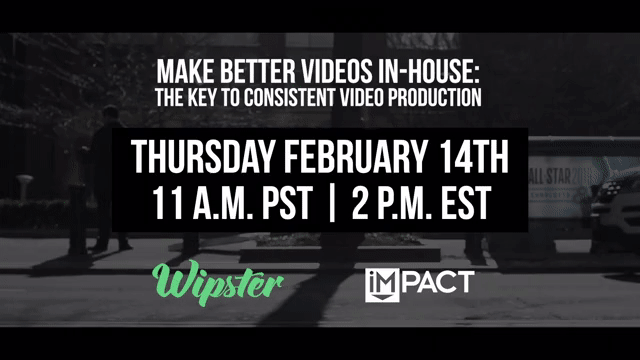
Chop Up Your Webinars
Trim the recorded version of your webinar into five-minute sections to create a quick and digestible content series. Share these clips on social media or within a Vidyard playlist. Make sure the discussion topics are clearly laid out and easy to hop between.
Learn From the Pros
Vidyard’s webinine series consists of short-form, 9-minute webinars for bite-sized viewing.
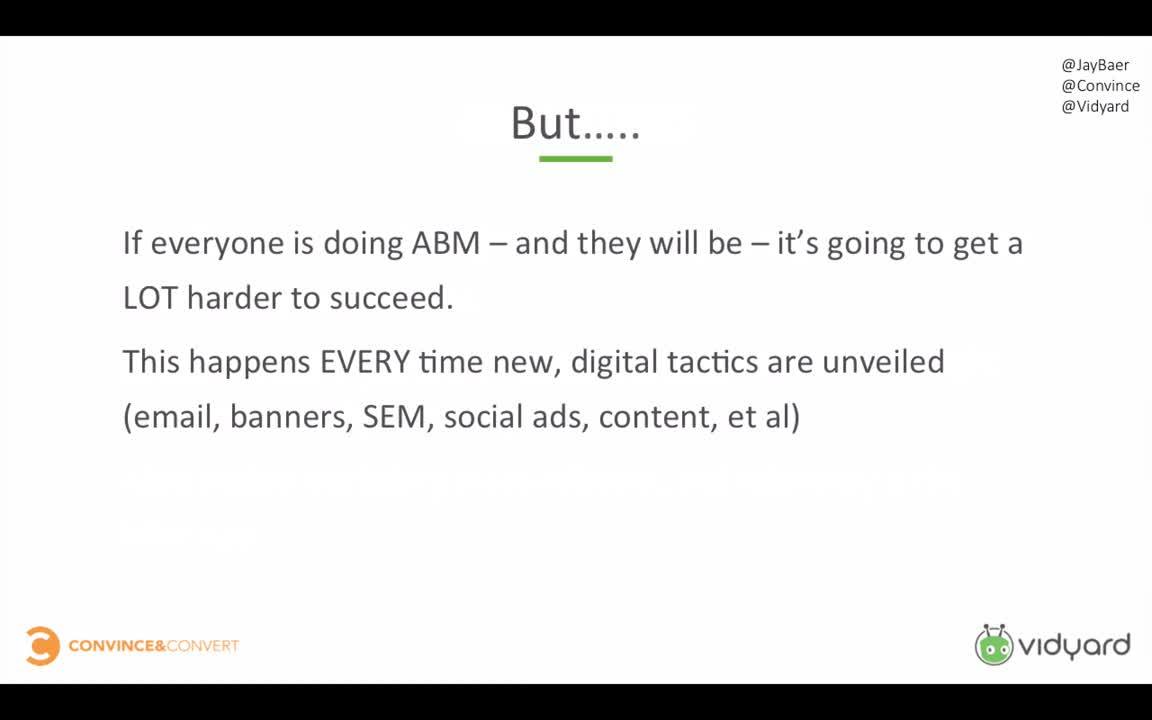
Create a Webinar Video Hub
If all your on-demand webinars exist in one place, they’ll be easy to find, easy to navigate, and easy to binge!
Learn From the Pros: Vidyard
This example is Vidyard’s hub where we make all of our webinars available for on-demand viewing. We’ve added a search feature to let our audience filter out what they really want to know. Try searching terms like, “sales,” or “abm.”

Score Those Webinar Leads
Hour-long webinars are a commitment. Chances are, the people watching them are your best candidates as future customers.
Keep track of your viewers with the traditional route of gating or use Vidyard analytics to assign a lead score based on consumption. For example, if a lead watches more than 50% of your webinar add score of ‘x’ to the lead.
Watch and Learn
Watch this video to learn more about lead scoring with video and why you need to include it in your marketing strategy.
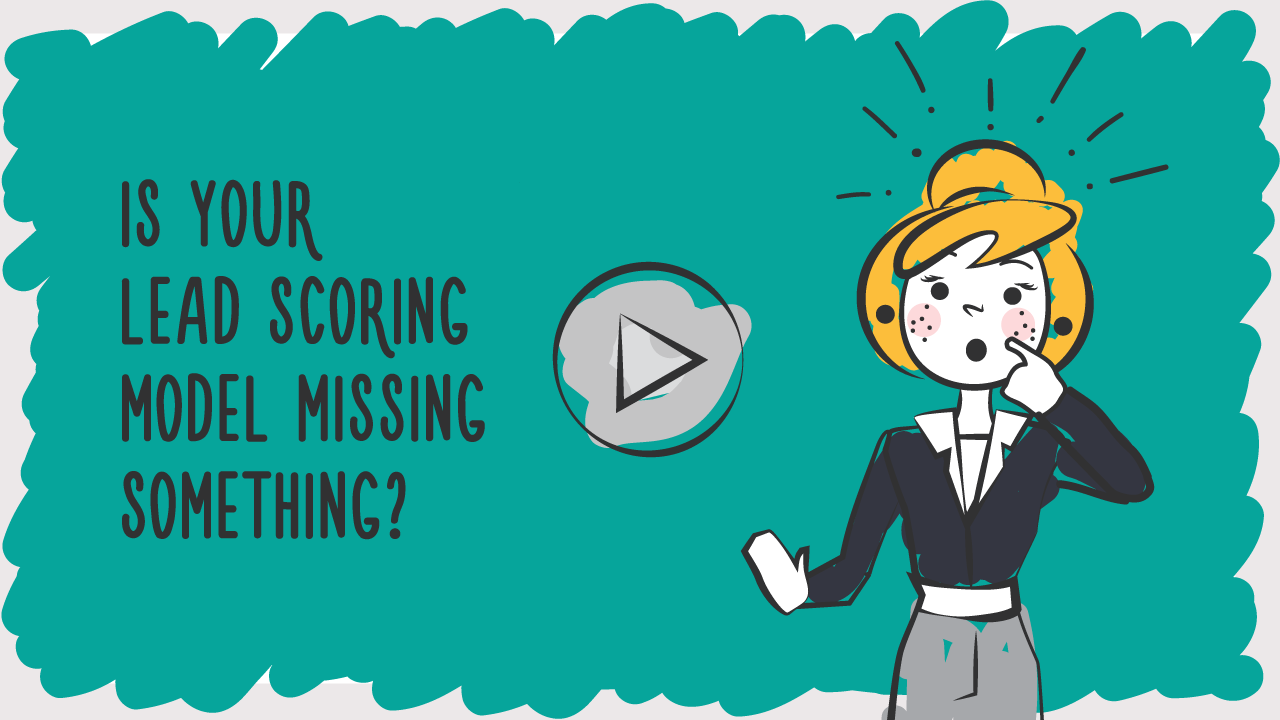
Stay in Touch with Webinar Attendees
Make sure to follow up with attendees to thank them (bonus points for using a personal video). Include a call to action like, “Watch it again,” or “Book a demo.”
You just gave your audience a valuable gift—don’t let this be goodbye!
Learn From the Pros
Jesse Ariss, Vidyard’s Senior Product Marketing Manager, made this webcam video to share in a follow-up email to attendees of his webinar, How to Create a Complete Video Marketing Strategy.

Where to Use Webinars
Webinars can be incredibly versatile, which means you can use and reuse them in a lot of ways across a lot of channels.
Webinar Hub: As mentioned above, a webinar hub is the best place to stream and permanently store on-demand webinars.
Landing Pages: If your webinar is part of a larger program such as a product launch or an event, you might live stream it from that program’s landing page to keep everything in the same place.
Social Media: Smaller segments of the webinar are optimal for LinkedIn, YouTube, and Facebook. Include a call to action that pushes people to watch the full version on your hub or website. (You might also use paid social in the same way.)
Email: Teasers and promo videos can be sent in advance via email to entice people to register, and the entire recorded version can be sent to attendees after the event.
Blog: You might write a blog post summarizing the takeaway knowledge from the webinar and embed the webinar in that post for readers who want to watch the full version.
Use Vidyard to Host Your Webinars
Host, manage, and share all of your webinars.
Examples of Webinars That Get it Right
One webinar is good, but many webinars are better. Offering an abundance of webinars (focused on your industry) will set you apart as a leader in your field and a voice to listen to.
This project management software gets down to the nitty gritty with product webinars for every specific use of their tool.
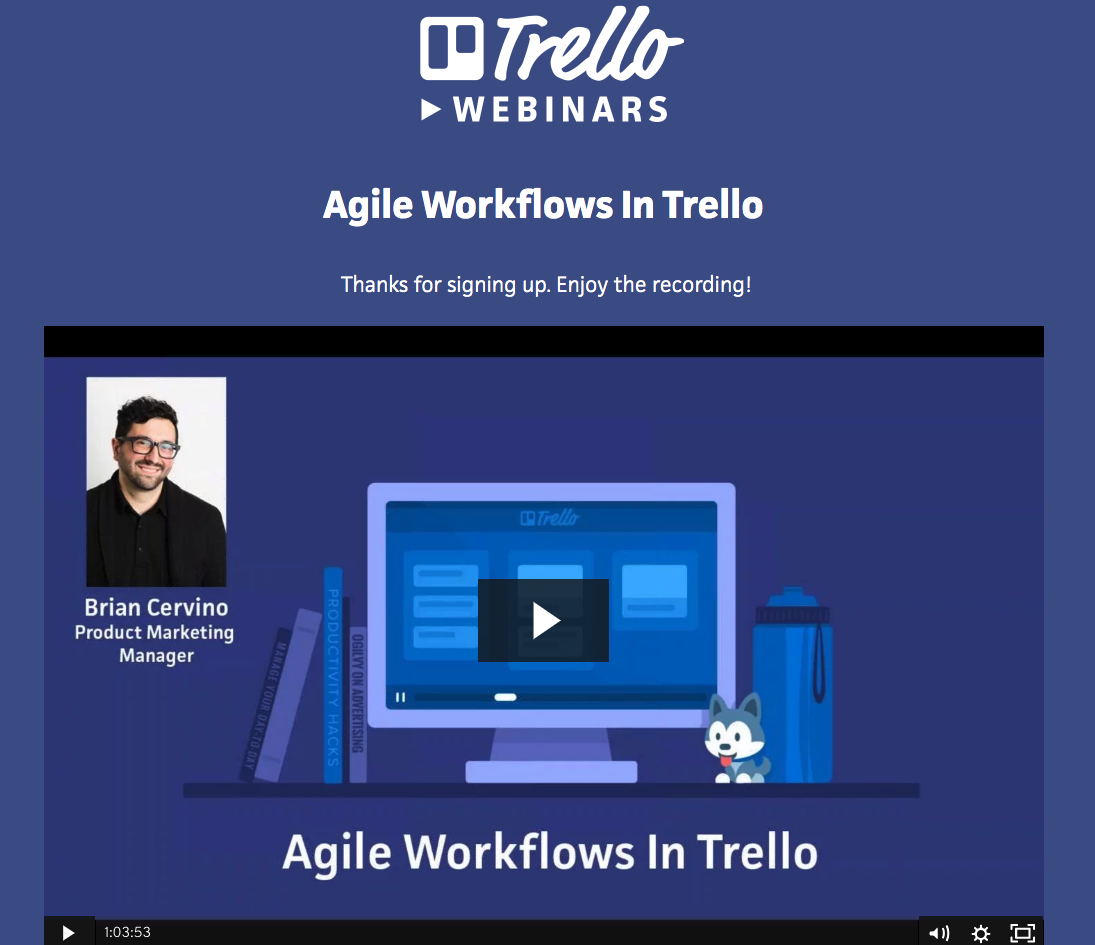
Providing educational resources to everyone, not just their customers, is part of the HubSpot brand. Their library of free webinars reflects that. You can find webinars about everything from SEO optimization to increasing ecommerce customer lifetime value. You name it, it’s probably on HubSpot.
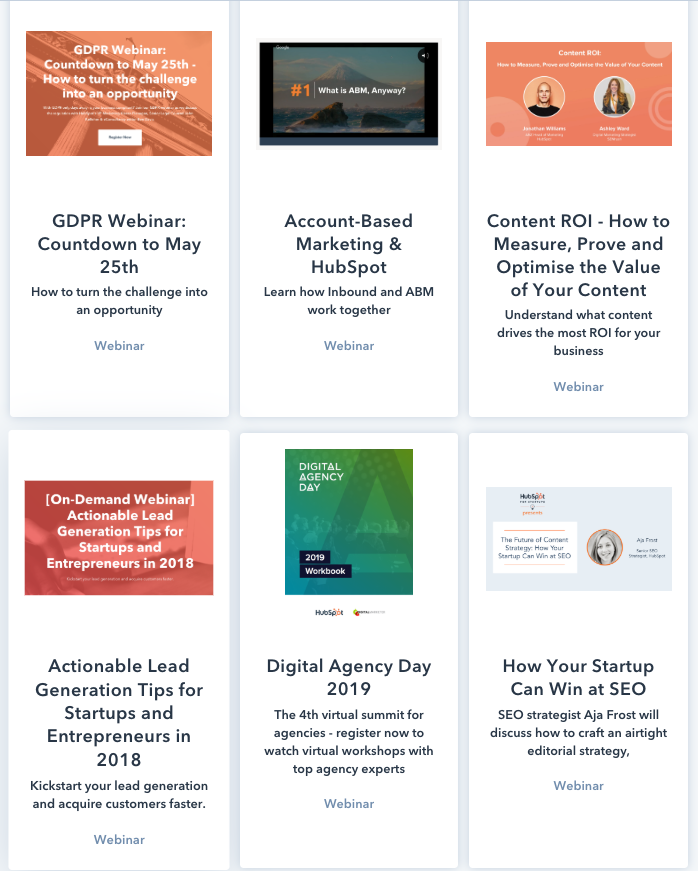
This marketing and sales company partners with peers and thought leaders to create educational webinars that are range from the practical (4 Steps to Quickly Growing Your Business Using Facebook Ads) to the high level (How to Make the Best Possible Decisions in a Chaotic World of Advice). IMPACT also offers to let viewers download the slidedeck for on-demand webinars.

We wouldn’t have published this blog post if we didn’t believe we were doing something right. Our webinars span the gamut from panel to educational. And we feature industry leaders and experts that bring the most value to our audience. From “How to Become a 1:1 Video Prospecting Pro,” to summarizing our annual “Video in Benchmark Report,” head to our webinar hub for fresh insights.
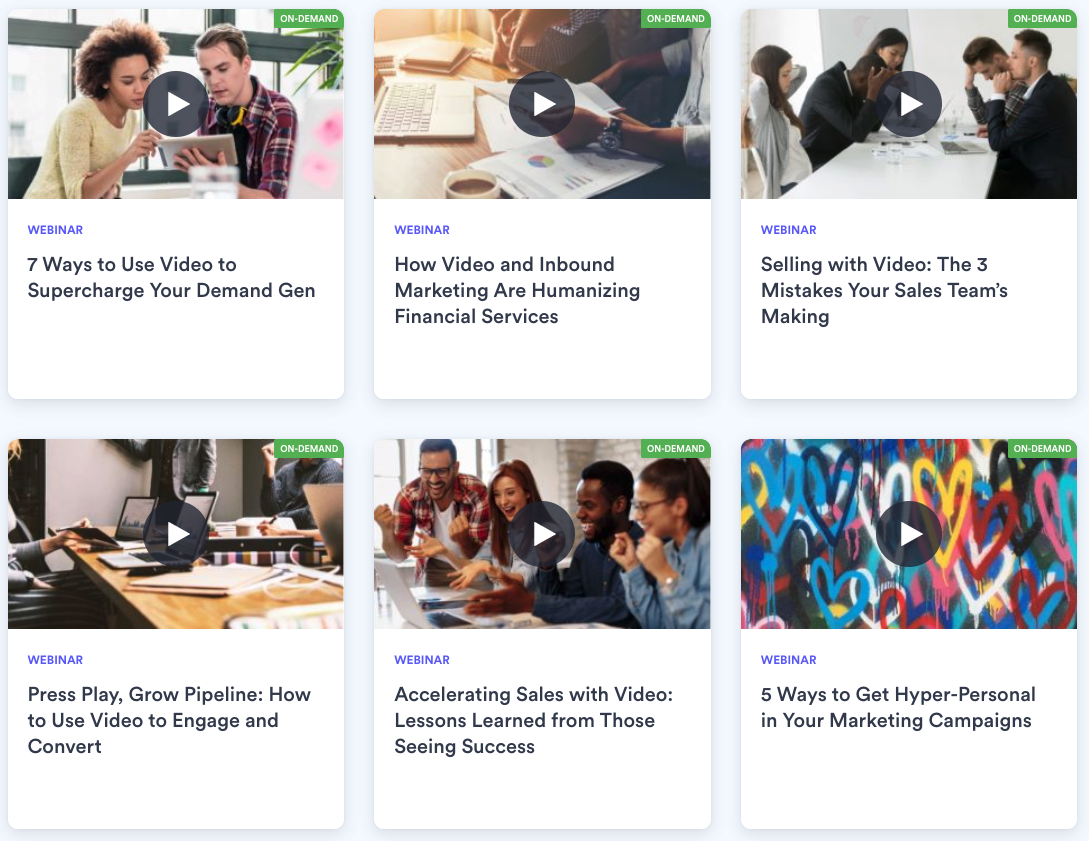

Get the Webinars Checklist
 Ready to make a webinar for your business? This list covers all the things you need to know to get it right.
Ready to make a webinar for your business? This list covers all the things you need to know to get it right.
Get the List
The post How to Make a Webinar Your Audience Will Love appeared first on Vidyard.
Read more: vidyard.com









